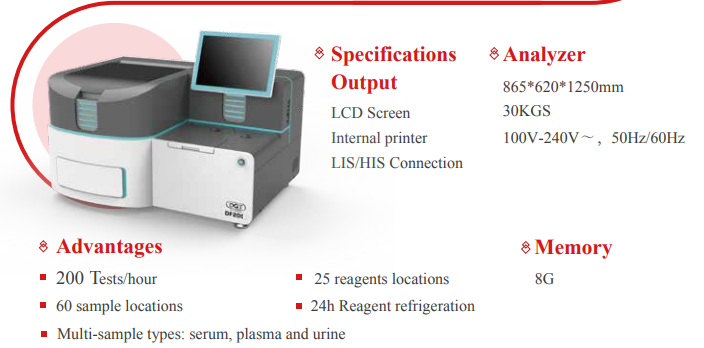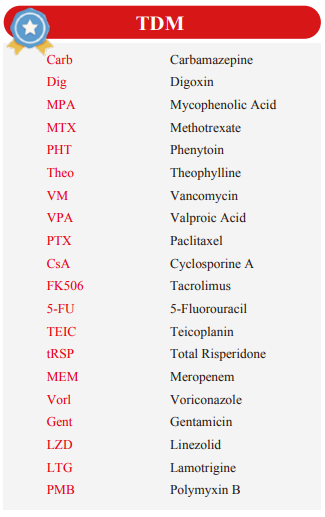During clinical drug treatment, such scenarios are often encountered:
Scene 1: There is a class of drugs, one point more is poisonous, and one point less is ineffective. How to accurately control the dosage?
Scene 2: When the same dose of medicine is used for different patients suffering from the same disease, the curative effect is often quite different, some have good effect, some have mediocre curative effect, some have no adverse reaction or mild, some have toxic reaction, severe cases even have life in danger. How to achieve individualized precision medicine?
Improving the popularization level of TDM requires a simple, convenient, fast and affordable solution!
As a national high-tech enterprise, since its establishment in 2013, Beijing Diagreat Biotechnologies Co., Ltd. has always been adhering to the development concept of 'deeply cultivating raw material research and development, adhering to independent innovation'. Relying on the core R&D advantages, Diagreat launches innovative products ranging from raw materials to reagents and instruments every year to provide the market and customers with high-quality, comprehensive and innovative diagnostic products and professional services. Another blockbuster new product was officially launched after Diagreat launched the point-of-care diagnostic POCT solution for therapeutic drug monitoring, therapeutic drug monitoring (TDM) chemiluminescence immunoassay solution, which uses alkaline phosphatase-labeled chemiluminescence detection technology. The test speed of the instrument is as high as 200T/H. It has high-throughput, large-sample, and fully-automatic detection performance. It truly achieves sample input and result output, unattended, and full-process quality control, stable and reliable results, which effectively provide comprehensive and perfect professional testing services for individualized rational drug use and precise diagnosis and treatment, to protect patients' drug safety!


No.1:Tacrolimus
Tacrolimus is mainly used in organ transplantation, skin diseases, atopic dermatitis, psoriasis, vitiligo and autoimmune diseases (lupus nephritis, systemic lupus erythematosus, etc.). Due to the narrow therapeutic window, given the same dose of tacrolimus, there will be different blood drug concentrations due to individual differences. Therefore, we must pay attention to the monitoring of tacrolimus blood drug concentration, and adjust the dosage according to the monitoring results, so as to reach the effective blood drug concentration as soon as possible within a certain period of time, and at the same time prevent drug poisoning concentration, which will lead to liver and kidney function damage, nausea, vomiting and hyperglycemia and other adverse reactions.
No.2:Cyclosporine A
Cyclosporine A is a new type of immunosuppressive drug, which is often used for rejection after organ transplantation (liver, kidney, heart, bone marrow, etc.) and autoimmune diseases (systemic lupus erythematosus, atopic dermatitis, nephrotic syndrome, etc.). Detection of its blood concentration has important clinical significance for improving the success rate of transplantation, preventing side effects (diabetes, kidney damage, neurotoxicity, gastrointestinal symptoms, hypertension, infection, tumor, etc.), and improving curative effect.
No.3:Mycophenolic acid
As an immunosuppressant, mycophenolic acid has strong immunosuppressive effect and low liver and kidney toxicity. It is clinically widely used to inhibit the rejection of kidney, liver, heart and other organ transplantation, improve the survival rate of patients and improve the quality of life of patients. Its clinically effective blood concentration is narrow, insufficient dosage of immunosuppressant will lead to organ rejection after transplantation, and excessive use will cause various toxic and side effects such as digestive system, blood system and infection. At the same time, due to many toxic reactions and many factors affecting drug metabolism, different individuals have different metabolizing abilities for drugs, and there are large inter-individual and intra-individual variations, and there are many differences in blood drug concentrations under the same drug dosage. Monitoring its blood concentration is used to formulate an individual immunosuppressant treatment plan, which can avoid toxic side effects and acute rejection.
No.4:Carbamazepine
Carbamazepine is the drug of choice for the treatment of simple and complex partial seizures, and can also be used for the treatment of peripheral neuralgia, neurogenic diabetes insipidus, prevention or treatment of manic depression, and against arrhythmias caused by digoxin poisoning. Its therapeutic range is narrow: 4-12 μg/mL, the range of effective blood drug concentration is narrow, individual differences are large, and the toxic reactions are mainly in the nervous system and digestive system. It is often difficult for clinicians to effectively control epilepsy with conventional doses of medication based on experience alone. Blood drug concentration testing is helpful for clinicians to design individualized dosing regimens for patients, to ensure medication safety, and to reduce the occurrence of adverse.
No.5: Valproic acid
Valproic acid is a broad-spectrum antiepileptic drug. It is the first choice for the treatment of epilepsy syndrome grand mal seizures, absence seizures, and myoclonic seizures and can also be used for various types of petit mal seizures, limited seizures, mixed epilepsy and febrile convulsions, etc., as well as for the treatment of manic episodes related to bipolar disorder. However, its therapeutic range is narrow: 50-100 μg/mL. Toxic reactions include central nervous system depression, fatal liver toxicity, etc. There are large individual differences in the in vivo process and curative effect. The correlation between blood drug concentration and drug effect is greater than that between dose and drug effect. There are many factors that affect the drug disposition of valproic acid. Monitoring blood drug concentration is conducive to rational drug use.
No.6:Phenytoin
Phenytoin is used to treat grand mal seizures, trigeminal neuralgia, manic depression, etc. At the same time, it is suitable for certain types of arrhythmias, especially ventricular and supraventricular arrhythmias caused by digitalis poisoning. However, the therapeutic range is narrow: 10-20 μg/mL, large individual differences, and neurotoxicity is the most common toxic reaction. In order to improve the safety and effectiveness of clinical medication, phenytoin is included in the routine therapeutic drug monitoring (TDM) program.
No.7:Vancomycin
The therapeutic window of vancomycin is narrow, the metabolism in the body is complex, and individual differences are large. Many factors and pathophysiological conditions may affect the concentration of vancomycin. Insufficient doses of vancomycin may affect the curative effect or cause drug resistance. Excessive concentrations increase the probability of nephrotoxicity and ototoxicity. Especially in the case of patients using aminoglycoside antibiotics, large doses of vancomycin, renal insufficiency, etc., monitoring the blood concentration of vancomycin is of great significance. Combine the concentration monitoring results with the patient's clinical symptoms and related laboratory tests to individualize medication for patients, select appropriate doses, and reduce the occurrence of bacterial drug resistance and adverse drug reactions.
No.8:Methotrexate
Methotrexate is an anti-folate antineoplastic drug, which mainly inhibits the synthesis of tumor cells by inhibiting dihydrofolate reductase, thereby inhibiting the growth and reproduction of tumor cells. It has a significant effect on a variety of malignant tumors, such as non-Hodgkin’s lymphoma, acute lymphoblastic leukemia, osteosarcoma, and malignant tumors of the head and neck. However, there are many adverse reactions of methotrexate, and the individual differences in its blood concentration are large. Therefore, the blood concentration of methotrexate should be monitored in time, rescue treatment and symptomatic treatment should be carried out in time until the blood concentration is lower than 0.05- 0.1 uM, which can effectively improve the drug effect and avoid serious side effects.
No.9:Digoxin
Digoxin is a commonly used digitalis preparation clinically, mainly used for congestive heart failure, atrial fibrillation, atrial flutter, paroxysmal tachycardia and premature beats. Digoxin acts quickly in the body, excretes quickly, and the therapeutic dose is close to the poisoning dose, but the poisoning reaction is extremely serious. The common clinical manifestations of digoxin poisoning include gastrointestinal symptoms, neuropsychiatric symptoms, and arrhythmia. Factors related to digoxin poisoning include age, gender, drug dose, electrolyte level, renal function, and combined drug use. Therefore, monitor its concentration in the clinic, adjust the drug dose according to the blood drug concentration, and actively carry out individualized drug use to reduce or avoid toxicity, promote the rational application of digoxin in clinical practice.
No.10:Theophylline
Theophylline is metabolized by liver enzymes, and when used in combination with liver enzyme inhibitors or inducers, the blood drug concentration will change and needs to be monitored at any time. The incidence of adverse reactions of theophylline is closely related to the blood concentration. The pharmacological action of theophylline is directly proportional to the blood concentration in the range of 5-20 mg/L, but the therapeutic window of theophylline is narrow, and the effective concentration is close to the toxic concentration. Moreover, the bioavailability of theophylline and the elimination rate in the body vary greatly among individuals, and the blood concentration of different patients with the same dose varies greatly. In order to ensure the safe and effective clinical application of theophylline and adjust the dose in time, an important clinical method is to monitor drug concentrations.
No.11:Voriconazole
Voriconazole is a new type of triazole broad-spectrum antifungal drug. It is an inhibitor of ergosterol biosynthesis. It mainly exerts antifungal effects by destroying fungal cell membranes and preventing fungal growth. It has good antibacterial activity mainly against acute invasive Aspergillus, severe fluconazole-resistant invasive Candida, actinomycetes and Fusarium. Common adverse reactions of voriconazole include neurological dysfunction, visual disturbance, abnormal liver function, renal dysfunction, etc. Clinically, more and more attention has been paid to monitoring the blood concentration of voriconazole. There are different opinions on the specific effective concentration range of voriconazole, but basically the same is that only when the trough concentration is > 1-2 ug/ml, can the clinical therapeutic level be fully obtained. However, when the trough concentration of voriconazole exceeds 5-6 ug/ml, the incidence of adverse reactions in patients is significantly increased. Excessive voriconazole trough concentration (≥6.0 ug/ml) is likely to cause neurotoxicity, visual disturbance and liver toxicity.
No.12:Linezolid
Linezolid, as a new type of synthetic oxazolidinone antibacterial drug, mainly binds to the 23S site of ribosomal RNA on the 50S subunit of bacteria, hinders the connection between mRNA and ribosomes, and prevents the 70S initiation complex formation and inhibit bacterial protein synthesis. Clinically, it is mainly used for the treatment of bacteremia caused by vancomycin-resistant enterococci, pneumonia and comprehensive skin infections caused by methicillin-resistant Staphylococcus aureus, and bacteremia caused by penicillin-resistant Streptococcus pneumoniae.
No.13:5-Fluorouracil
5-Fluorouracil is one of the most widely used antineoplastic drugs in clinical practice, especially in the treatment of digestive system tumors, it is the basic drug. Studies have shown that the pharmacokinetics of 5-Fluorouracil is closely related to clinical efficacy, and the higher the blood concentration, the patients will obtain more objective curative effect accordingly, but the damage to the patient’s body is also greater.
No.14:Risperidone
Risperidone is a psychiatric drug mainly used to treat schizophrenia, bipolar disorder, and irritability in people with symptoms of autism. 9-hydroxyrisperidone is the active metabolite of risperidone, so evaluating the total concentration of risperidone and 9-hydroxyrisperidone is of great significance for clinical rational drug use.
No.15:Paclitaxel
Paclitaxel has a good effect in the treatment of ovarian cancer, cervical cancer and other gynecological tumors, as well as non-small cell lung cancer and esophageal cancer. Studies have shown that the blood drug concentration of paclitaxel is related to its adverse reactions after chemotherapy, and the time when the blood drug concentration of paclitaxel > 0.05 μmol/L is closely related to toxic and side effects. If the value of Tc>0.05 (the time when blood concentration>0.05 μmol/L) is obtained by detecting the blood drug concentration and using pharmacokinetic principles, the adverse reaction status of paclitaxel can be judged, and an individualized dosing regimens can be formulated according to the results.